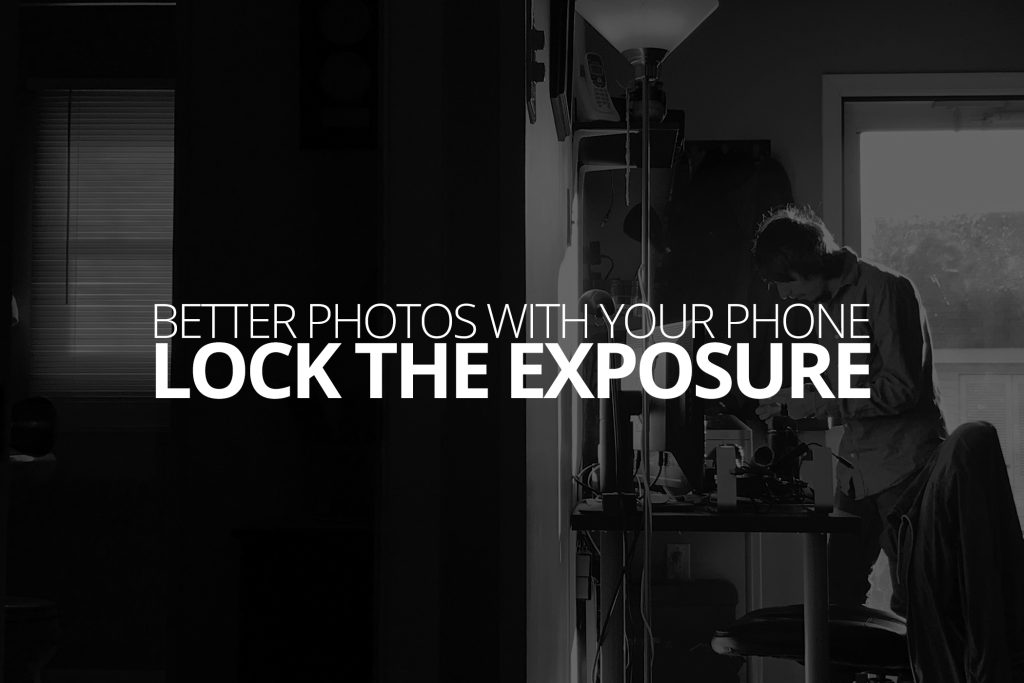This issue of Better Photos With Your Phone is back this week with a quick and powerful tip for getting better photos in your every day shooting situations. Up until this point, we’ve been discussing the mindset of taking a good picture broadly, and some of the basic rules, challenges and techniques you can use to improve the images you take. We have left all the settings up to the phone to decide what’s best. Now, we’re going to wade just ankle deep into messing with those settings yourself.
Don’t worry, we’re not going to pile on much right now. Just one simple thing: Locking the exposure. So, before we move onto that, lets talk about the problem that we’re going to solve.
If you remember from earlier in the series, ‘exposure’ is basically just how bright the things in your image are. So locking the exposure, in this context, means freezing whatever settings the camera has chosen for a specific scene so that you can move the camera and use those settings on a different scene. Now, you might be wondering why anyone would want to do that, so let’s unpack the problem a little bit more.
The Problem
So imagine you’re enjoying lunch on the patio of a local restaurant with some friends you don’t get to see very often. This is the perfect time for a photo, but when you get up to take the picture, everyone is too dark under the restaurant’s awning. The sun bathed pavement in the background is looking great, but that’s not what you want a picture of! This is a problem that locking the exposure will solve.
Now, the truth is that modern phones are getting quite good at recognizing faces, and adjusting accordingly. So, that example up there might not be the most likely one you’ll encounter, though it does demonstrate the essence of the problem: Your phone doesn’t always know what you want the picture to look like and sometimes it’s guesses are well… not great. Any time there is high contrast (dark shadows and bright lights close to each other) in your scene, and especially if there are no faces looking directly at the camera, it’s anyone’s guess whether the phone will guess correctly.
You can do a quick an easy experiment to see this problem in action.
Turn on your TV and draw the blinds so that the room is dimmed, but not totally dark. Stand back and point the camera toward the TV. You’ll notice that the phone thinks you want to take a picture of the room, so the tv screen will look so bright that you can barely make out what’s on it. Now use your finger to tap on the TV in the picture. The camera will immediately adjust the picture, making it darker, so the picture on the tv shows up clearly. You just told the phone to adjust the exposure. That’s a useful trick, but we’re not done yet because it’s not too often in real life that you’re trying to take a picture of the TV like that.
So, lets continue the experiment. Pretend that you don’t like the angle on your TV photo, and change positions a little bit. Maybe take a step to the left, or crouch down. Now look at the picture again. Unless you held the camera very still as you moved, the picture has probably reset and once again you cannot make out what’s on the TV screen. That is why locking the exposure is such a useful trick.
Of course, as I said, it’s not likely that you’re going to find yourself needing to take pictures of TV’s very often, and the phone is quite good at recognizing and providing good settings for images with faces in them. So, the places you’re most likely to find yourself needing this are when the scene is unpredictable, or simply something pretty or picturesque that you’ve noticed and want to capture—a sunset, or a picture out of a car window, for example. But, at the same time, when you want to take these kinds of images, locking your exposure is often the only way to do it.
How to lock exposure on your phone’s camera
The method for locking the exposure on your phone’s camera will depend on the manufacturer. Apple’s iPhone is the easiest and most consistent across all models. Simply tap and hold the screen where you’d like to lock the exposure. So, in our experiment with the TV, just tap and hold on the TV until the little confirmation box flashes at you. Go ahead and move the camera around, and you’ll see the exposure won’t change no matter where you point it.
If you own a phone running Android (almost anything that isn’t an iPhone), the method will depend on the specific manufacturer (Samsung, LG, HTC, etc), and might require a third party camera app that supports it. Android phones running version 4 or higher do not need a special camera app, and the tap and hold functionality is basically the same as Apple’s iPhone. Just tap and hold until it flashes or beeps.
Next time
Go ahead and try this out the next time you’re at one of the kid’s night time ball games and the field is too bright against a dark sky, or the next time you want that cute photo of your dog peering in through the glass door begging to come inside. It will take some practice to remember to use this trick, but if you do, you’ll get some really great images that not only would have been crappy otherwise, but that you probably just wouldn’t have taken at all.
Next time we’ll be talking about when and how to get trigger happy, and more importantly, not to get trigger happy too much. Until then, send us your shots on Twitter! Happy shooting!

